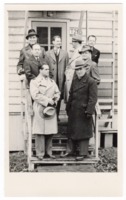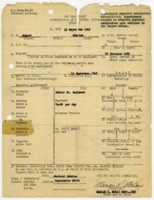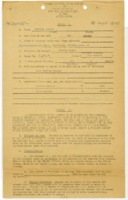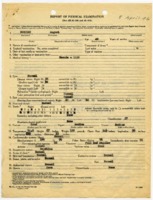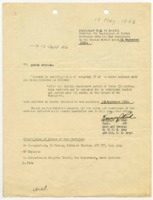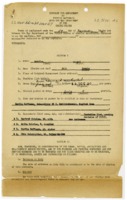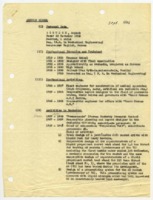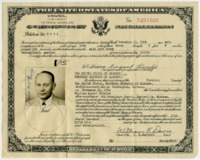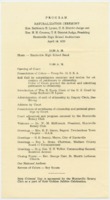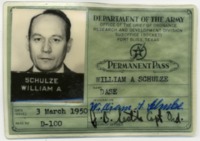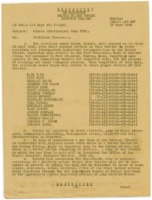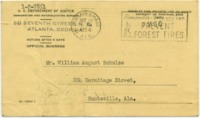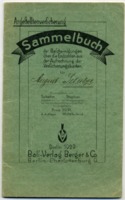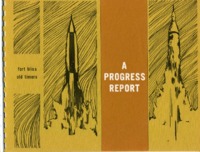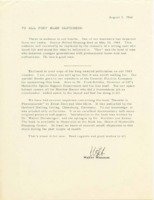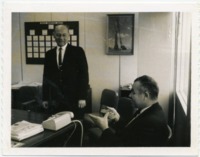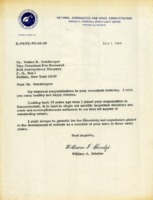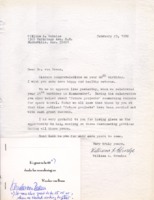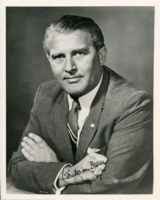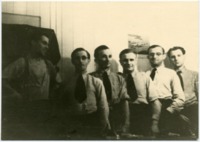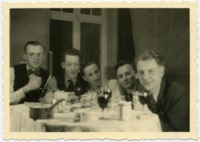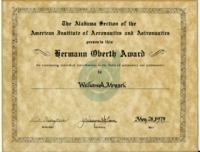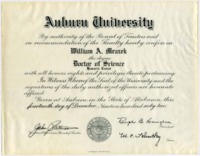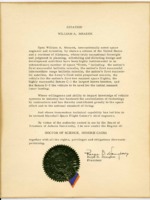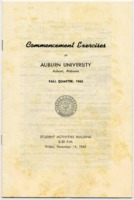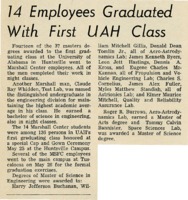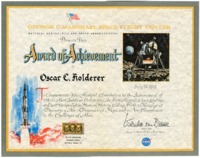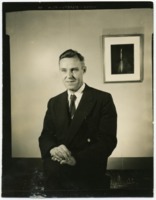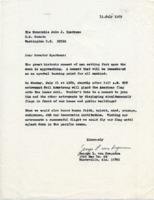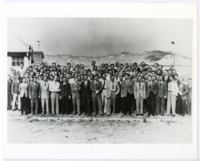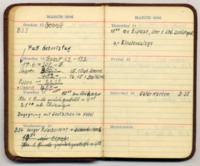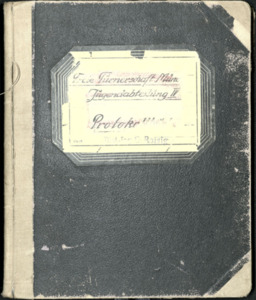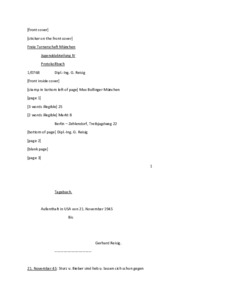
Browse Items (36 total)
Sort by:
-
Bernhard Tessmann and William A. Schulze with a group at Fort Bliss, Texas.
Tessmann is standing on the front row on the far left. Schulze is standing directly behind him. Tessmann and Schulze were both engineers who were relocated from Germany to the United States as part of Operation Paperclip after World War II. -
U. S. War Department Notification of Personnel Action.
This document includes details about Schulze's transfer to the United States after World War II, including his health and the terms of his employment as an engineer. -
Letter from August Schulze in Aberdeen, Maryland to Trude and Erika Schulze in Landshut, Bavaria, Germany.
Schulze wrote this letter to his wife, Trude, and daughter, Erika, on the back of a photostat copy of his War Department Notification of Personnel Action. In the letter, he discusses his pay and accommodations with the U. S. Army. -
Special Contract for Employment of German Nationals with the War Department in the United States.
This special contract outlines the conditions of August Schulze's employment as an engineer in the United States. The document also includes instructions regarding the engineers' housing, dependents, mail, termination of contract, and burial. -
Report of Physical Examination.
This report documents August Schulze's physical condition after his arrival in the United States. -
Supplements to Special Contract for Employment of German Nationals with the War Department in the United States.
The two supplements extend August Schulze's employment in the United States to November 21, 1946. On the back of Supplement No. 2, Schulze lists amenities and their prices. -
Contract for Employment of Foreign Nationals with the War Department of the United States.
This contract outlines employee benefits, policies regarding the movement of dependents from Germany to the United States, and conditions of secrecy, noting that "as a condition to admittance to this country and employment hereunder, employee agrees to observe such security measures as the President of the United States may direct with respect to the project here involved." The contract also includes an enclosure clarifying that Schulze's wife and daughter may move to the United States as soon as possible. -
Résumé of August Schulze.
This résumé outlines Schulze's professional activities and activities in rocketry. The document notes his interrogation by the United States and outlines plans for his "Contemplated Activity" as "Chief of the Subsection 'Thrust Unit'." -
1946 day book.
Written by William A. Schulze, this day book includes notes from his activities at Army Proving Ground at Aberdeen, Maryland in early 1946. Schulze was transported from Germany to Aberdeen in late 1945 as part of the first group of German engineers sent to the United States. During the week of March 17-23, Schulze records his travel from Aberdeen to El Paso, Texas, leaving on Monday, March 18, and arriving in Texas on Thursday, March 21. The day book includes entries on shopping, leisure activities, birthdays, and mail. Schulze's notes reference H. N. Toftoy, Konrad Dannenberg, Wilhelm Jungert, Hannes Luehrsen, Theo Poppel, Erich Neubert, Walter Schwidetski, and others. -
Naturalization ceremony program.
Held at the Huntsville High School auditorium, the ceremony naturalized many of the German engineers who were transferred to Huntsville in 1950. -
Department of the Army Permanent Pass.
This pass was issued by the Office of the Chief of Ordnance, Research and Development Division Suboffice (Rocket), at Fort Bliss, Texas. -
Orders for the transportation of seventeen German civilians to the United States.
This document identifies the first group of German engineers to be brought to the United States as part of Operation Paperclip. Seven of the men listed were eventually transported to the U. S. Army post at Fort Bliss, Texas: Wernher von Braun, Wilhelm Jungert, Erich Neubert, Theo Poppel, Eberhard Rees, August Schulze, and Walter Schwidetski. The men were transported from Germany by air and then by train once in the United States. -
"Notice to Petitioner."
This card was sent from the U. S. Department of Justice Immigration and Naturalization Service in Atlanta, Georgia to William August Schulze. The card serves as notification of his naturalization hearing at the Post Office Building in Birmingham, Alabama, on November 11, 1954. Typed instructions at the bottom of the card read, "BRING YOUR ALIEN REGISTRATION CARD WITH YOU." Schulze was later naturalized in Huntsville on April 14, 1955. -
German state health insurance book and cards belonging to William August Schulze.
This booklet, "Sammelbuch der Bescheinigung über die Endzahlen aus der Aufrechnung der Versicherungskarten für August Schulze," documents Schulze's government health insurance while he was employed in Germany from 1930 through 1944. Each page serves as an insurance card for each year of employment. Page seven marks Schulze's first insurance record as an employee at Peenemünde. -
"Fort Bliss Old Timers: A Progress Report."
Subtitled "Some of the Old Timers' Contributions to the Science of Space," this booklet commemorates the accomplishments of the group of engineers posted at Fort Bliss, Texas, beginning in 1945. It includes a brief history of rocket development in Germany from 1929 through 1944, photographs of the 1965 Old Timers Reunion, and a directory of the oldtimers. It also includes a transcript of a speech given by Wernher von Braun in honor of Walter Dornberger's retirement. -
1963 Fort Bliss Old Timers Reunion booklet and letter.
The materials include a letter from Walter Wiesman and an Old Timers Reunion booklet. The booklet includes reproduced news clippings, the reunion program, and photographs from Fort Bliss, as well as photographs of reunion attendees and activities with subjects identified. The reunion booklet also includes photographs from a meeting of the Alabama Section of the American Institute of Aeronautics and Astronautics. -
William A. Schulze and Hans Palaoro at Marshall Space Flight Center.
The bulletin board behind Schulze reads "Vehicle Engineering Branch." Palaoro was the head of the Vehicle Systems Engineering Branch of the Structures and Mechanics Division at Marshall Space Flight Center. -
Correspondence between William A. Schulze in Huntsville, Alabama, and Walter Dornberger in Buffalo, New York.
In his letter to Dornberger, Schulze congratulates him on his seventieth birthday and notes, "Looking back 29 years ago when I joined your organization in Kummersdorf, it is hard to single out specific important decisions you made and accomplishments achieved; to me they all appear of outstanding nature. I shall always be grateful for the friendship and experience gained in the development of rockets as a member of your team in those early years." Dornberger's reply is enclosed. -
Correspondence related to Wernher von Braun's sixtieth birthday.
The materials include a congratulatory note from William A. Schulze to von Braun, in which he notes, "To me it appears like yesterday, when we celebrated your 25th birthday in Kummersdorf." Von Braun's response, handwritten on a card, reads: "It was also great to be 25 or so, when we started working together!" Enclosed are instructions from Eberhard Rees encouraging Marshall retirees to send von Braun personalized birthday wishes for inclusion in a bound volume later. -
Engineers at Peenemünde, Germany.
From left to right, the photograph shows Oscar Holderer, Mayerhöfer, Gerhard W. Kraus, Nimz, William A. Mrazek, and Kurt Patt. -
Group of engineers, probably at Peenemünde, Germany.
From left to right, the photograph shows William A. Mrazek, Arthur Kröger, unidentified, Gerhard W. Kraus, and Kurt Patt. -
Wernher von Braun, William A. Mrazek, and M.E. Huston with a rocket nose cone recovered from space.
The photo is signed by Von Braun, Mrazek, and Huston. -
Hermann Oberth Award certificate presented to William A. Mrazek.
Mrazek was the 1978 recipient of the Oberth Award. During his career, Mrazek worked on the design and development of the Jupiter ICBM, Jupiter-C, and Saturn launch vehicles. He retired from Marshall Space Flight Center as the Associate Director for Engineering in Project Development in 1973. -
Citation for Doctor of Science, Honoris Causa degree presented to William A. Mrazek.
Given by Auburn University president Ralph Brown Draughon, the citation notes Mrazek's accomplishments as "Marshall Space Flight Center's chief engineer." -
Commencement Exercises of Auburn University, fall quarter 1962.
The program includes the presentation of Doctor of Science, Honoris Causa, to William A. Mrazek. -
"14 Employees Graduated With First UAH Class."
Clipping from the Marshall Star, May 29, 1968, vol. 8, no. 36. -
Letter from George L. von Pragenau in Huntsville, Alabama to Senator John J. Sparkman in Washington, D.C.
Von Pragenau suggests to Sparkman that residents of Huntsville should display American flags outside their homes and businesses at the same moment that "astronaut Neil Armstrong will plant the American flag onto the lunar soil." He wrote a similar letter to Huntsville mayor Joe Davis. -
Group photograph of transplanted German engineers at Fort Bliss, Texas.
This photo is a reprint of the original. -
Excerpt from the 1946 daybook of William A. Schulze.
This excerpt includes pages 36 and 37 of the daybook. In the entries, Schulze notes his travel to Fort Bliss, Texas from Aberdeen, Maryland. A translation is included. -
1945-1946 Journal of Gerhard Reisig Dipl.-Ing.
Gerhard Reisig Dipl.-Ing., later Dr. Gerhard Reisig, was a German-American rocket scientist that worked on the team of von Braun at Fort Bliss. This journal covers his journey to the United States under Operation Paperclip, and includes descriptions of his experience to and through his arrival on December 6th, 1946. In this journal, he discusses numerous parts of his travel and experience in the United States including the rail route taken by the group he was in, reviews of two films of the time, comments on fashion and American society, as well as periodic mentions of food culture especially early in the journal. He additionally copies several articles by hand, some in English, some translated, from periodicals, particularly Time magazine. -
Transcript of 1945-1946 Journal of Gerhard Reisig Dipl.-Ing.
Gerhard Reisig Dipl.-Ing., later Dr. Gerhard Reisig, was a German-American rocket scientist that worked on the team of von Braun at Fort Bliss. This journal covers his journey to the United States under Operation Paperclip, and includes descriptions of his experience to and through his arrival on December 6th, 1946. In this journal, he discusses numerous parts of his travel and experience in the United States including the rail route taken by the group he was in, reviews of two films of the time, comments on fashion and American society, as well as periodic mentions of food culture especially early in the journal. The transcript includes links to copies of the articles he transcribed by hand if they could be found.
